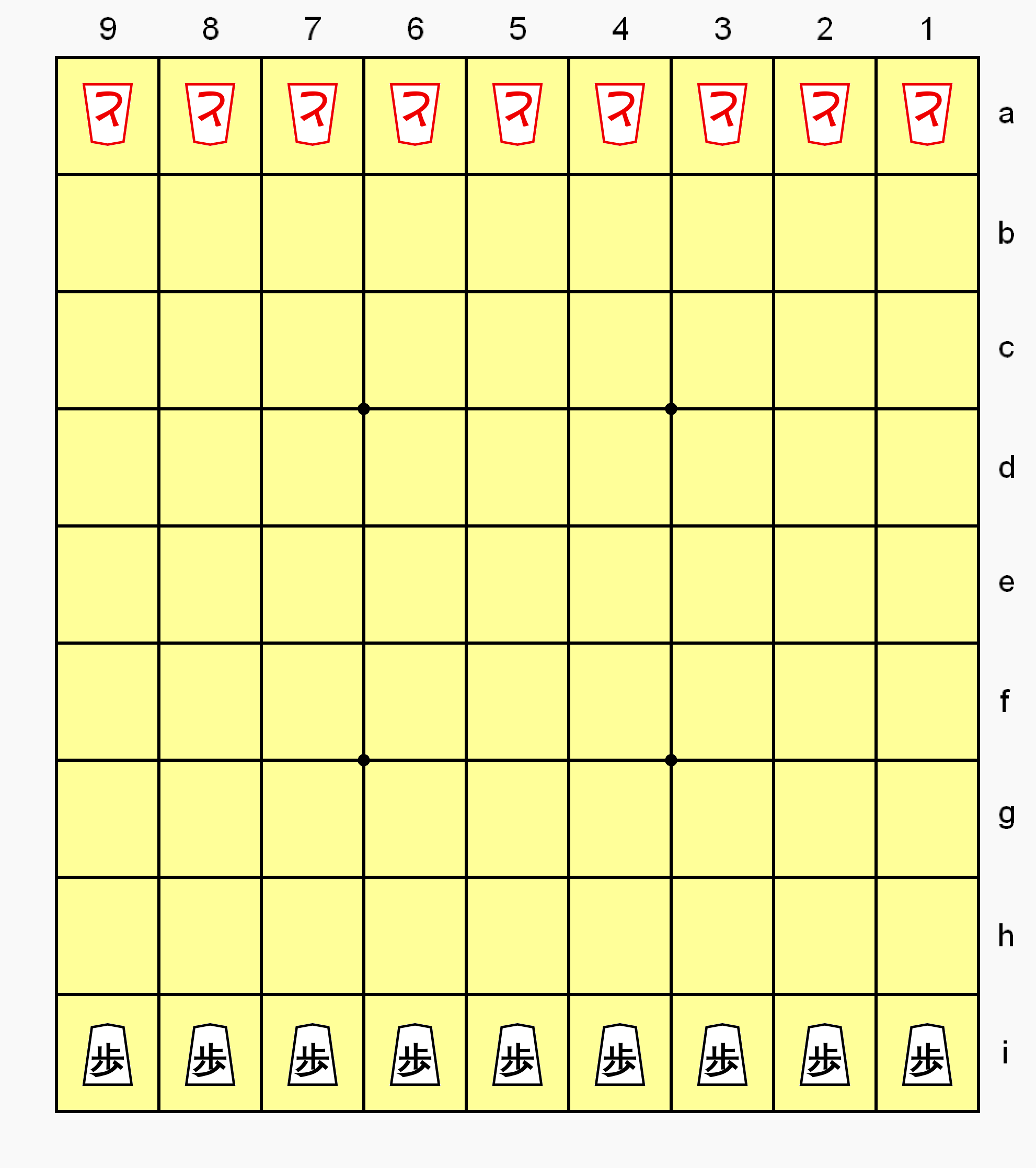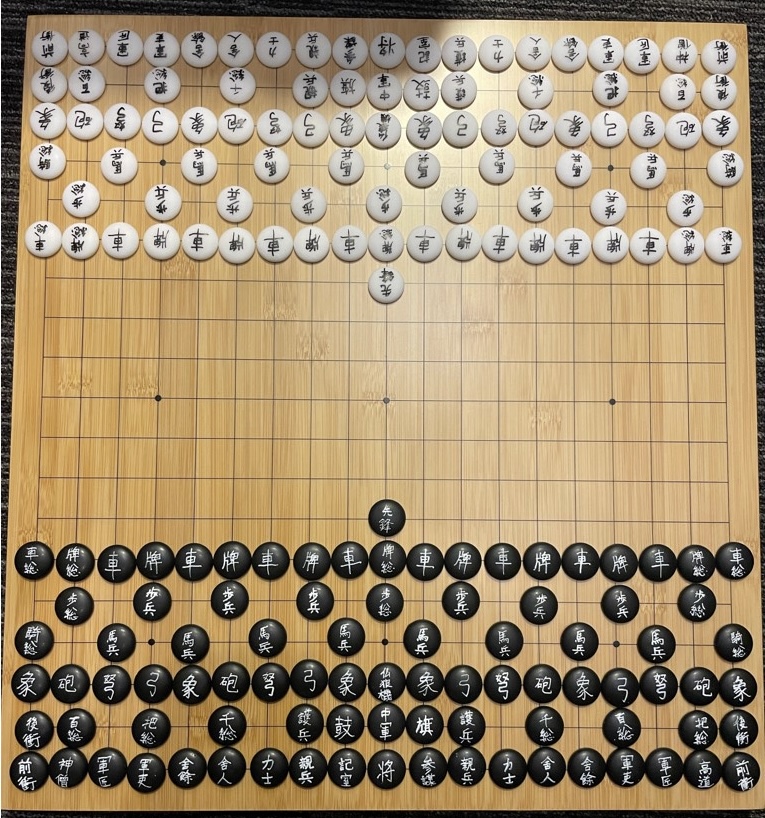|
Annan Shogi
Annan shogi ( ja, 安南将棋 ) also called Korean shogi, is a variant of shogi (Japanese chess). Annan shogi is a popular shogi variant in Japan. Gameplay The game is played as standard shogi, except that, when a piece has a friendly piece on the square directly behind it, it has the movement of that piece instead of its own. A variant rule is that a piece may move like any friendly piece that protects it. The setup is somewhat different from standard shogi. The game should not be confused with Korean chess, a variant of chess that is played in Korea, but which resembles xiangqi (Chinese chess) rather than shogi. Setup See also * Shogi variant ** Whale shogi ** Hasami shogi ** Unashogi ** Ko shogi * Knight relay chess Knight relay chess (also called N-relay chess) is a chess variant invented by Mannis Charosh in 1972. In this game, knights "relay" their power to friendly pieces. Rules The rules are the same as those of orthodox chess except as follows. Any pie . ... [...More Info...] [...Related Items...] OR: [Wikipedia] [Google] [Baidu] |
Shogi Variant
A shogi variant is a game related to or derived from shogi (Japanese chess). Many shogi variants have been developed over the centuries, ranging from some of the largest chess-type games ever played to some of the smallest. A few of these variants are still regularly played, though none are as popular as shogi itself. The drop rule, often considered the most notable feature of shogi, is absent from most shogi variants, which therefore play more like other forms of chess, with the board becoming less crowded as pieces are exchanged. This is especially true for variants larger than shogi itself − in fact, the largest well-known variant that features the drop rule is the 11×11 game wa shogi. Predecessors of modern shogi Some form of chess had almost certainly reached Japan by the 9th century, if not earlier, but the earliest surviving Japanese description of the rules of chess dates from the early 12th century, during the Heian period. Unfortunately, this description does not ... [...More Info...] [...Related Items...] OR: [Wikipedia] [Google] [Baidu] |
Shogi
, also known as Japanese chess, is a strategy board game for two players. It is one of the most popular board games in Japan and is in the same family of games as Western chess, ''chaturanga, Xiangqi'', Indian chess, and '' janggi''. ''Shōgi'' means general's (''shō'' ) board game (''gi'' ). Western chess is sometimes called (''Seiyō Shōgi'' ) in Japan. Shogi was the earliest chess-related historical game to allow captured pieces to be returned to the board by the capturing player. This drop rule is speculated to have been invented in the 15th century and possibly connected to the practice of 15th century mercenaries switching loyalties when captured instead of being killed. The earliest predecessor of the game, chaturanga, originated in India in the sixth century, and the game was likely transmitted to Japan via China or Korea sometime after the Nara period."Shogi". ''Encyclopædia Britannica''. 2002. Shogi in its present form was played as early as the 16th century, while ... [...More Info...] [...Related Items...] OR: [Wikipedia] [Google] [Baidu] |
Janggi
''Janggi'' (including romanizations ''changgi'' and ''jangki''), sometimes called Korean chess, is a strategy board game popular on the Korean Peninsula. The game was derived from xiangqi (Chinese chess), and is very similar to it, including the starting position of some of the pieces, and the 9×10 gameboard, but without the xiangqi "river" dividing the board horizontally in the middle. Janggi is played on a board nine lines wide by ten lines long. The game is sometimes fast paced due to the jumping cannons and the long-range elephants, but professional games most often last over 150 moves and so are typically slower than those of Western chess. In 2009, the first world janggi tournament was held in Harbin, Heilongjiang, China. Rules Board The board is composed of 90 intersections of 9 vertical files and 10 horizontal rows. The board has nearly the same layout as that used in xiangqi, except the janggi board has no "river" in the central row. The pieces consist of disks mark ... [...More Info...] [...Related Items...] OR: [Wikipedia] [Google] [Baidu] |
Xiangqi
''Xiangqi'' (; ), also called Chinese chess or elephant chess, is a strategy board game for two players. It is the most popular board game in China. ''Xiangqi'' is in the same family of games as '' shogi'', '' janggi'', Western chess, '' chaturanga'', and Indian chess. Besides China and areas with significant ethnic Chinese communities, this game is also a popular pastime in Vietnam, where it is known as , literally 'general chess'. The game represents a battle between two armies, with the primary object being to checkmate the enemy's general (king). Distinctive features of xiangqi include the cannon (''pao''), which must jump to capture; a rule prohibiting the generals from facing each other directly; areas on the board called the ''river'' and ''palace'', which restrict the movement of some pieces but enhance that of others; and the placement of the pieces on the intersections of the board lines, rather than within the squares. Board Xiangqi is played on a board nine lin ... [...More Info...] [...Related Items...] OR: [Wikipedia] [Google] [Baidu] |
Whale Shogi
Whale Shogi (鯨将棋 ''kujira shōgi)'' is a modern variant of shogi (Japanese chess). It is not, however, Japanese: it was invented by R. Wayne Schmittberger of the United States in 1981. The game is similar to Judkins shogi, but with more pieces, and the pieces are named after types of whale. Game rules Objective The objective of the game is to capture your opponent's white whale. Game equipment Two players, Black and White (or 先手 ''sente'' and 後手 ''gote),'' play on a board ruled into a grid of 6 ranks (rows) by 6 files (columns). The squares are undifferentiated by marking or color. Each player has a set of 12 wedge-shaped pieces, of slightly different sizes. From largest to smallest (most to least powerful) they are: *1 white whale (W) *1 porpoise (P) *1 humpback (H) *1 gray whale (G) *1 narwhal (N) *1 blue whale (B) *6 dolphins (D) Each piece has its initial written on its face. On the reverse side of the porpoise is another letter (K for 'killer whale'), often ... [...More Info...] [...Related Items...] OR: [Wikipedia] [Google] [Baidu] |
Hasami Shogi
Hasami shogi (はさみ将棋 ''hasami shōgi'', "intercepting chess") is a variant of shogi (Japanese chess). The game has two main variants, and all Hasami variants, unlike other shogi variants, use only one type of piece, and the winning objective is not checkmate. One main variant involves capturing all but one of the opponent's men; the other involves building an unbroken vertical or horizontal chain of five-in-a-row. Hasami shogi possesses simple rules while offering complex strategy. Variant 1 is popular among Japanese children.Pritchard (1994), p. 65 Variant 1 Play is on a traditional shogi board, with each player having nine men. Traditional shogi pawns (''fu'') can be used as men; unpromoted pawns (歩) for Black (先手 ''sente''), promoted pawns (と) for White (後手 ''gote''). At the start of the game each player's pieces fill their first , with Black's men on the lower side of the board. Black moves first, then players alternate turns. A player wins by capturing a ... [...More Info...] [...Related Items...] OR: [Wikipedia] [Google] [Baidu] |
Ko Shogi
Kō shōgi (広将棋 or 廣象棋 'broad chess') is a large-board variant of shogi, or Japanese chess. The game dates back to the turn of the 18th century and is based on xiangqi and go as well as shogi. Credit for its invention has been given to Confucian scholar Ogyū Sorai (1666–1728), who also described the rule of the game in his book, Kōshōgifu (廣象棋譜). Rules of the game Unlike standard shogi, pieces may not be dropped back into play after being captured. Promotion rules are complex, and the fates of several pieces are interdependent. Objective The objective is to capture the opponent's commanding pieces: The general, plus, if present, the governor; otherwise, the banner ''or'' middle army. Game equipment Two players, Black and White, play on a go board ruled into a grid of 19 ''ranks'' (rows) by 19 ''files'' (columns) with a total of 361 intersections. Each player has a set of 90 pieces of 34 different types. The pieces are round and flattened lik ... [...More Info...] [...Related Items...] OR: [Wikipedia] [Google] [Baidu] |
Knight Relay Chess
Knight relay chess (also called N-relay chess) is a chess variant invented by Mannis Charosh in 1972. In this game, knights "relay" their power to friendly pieces. Rules The rules are the same as those of orthodox chess except as follows. Any piece, except for the king, that is defended by a friendly knight has the power, in addition to its normal abilities, to move like an orthodox knight. The piece loses the additional power as soon as it is no longer defended by a friendly knight. The knight itself is immune from capture, cannot capture enemy pieces and cannot give check. A pawn can be promoted to a new knight, which has the same properties. A pawn may not move to or attack its first or last rank using relayed knight power. If a pawn is relayed to its initial rank, it regains the option to make a double-step move. There is no ''en passant'' capture. Example The diagram shows possible moves of the white pawn on e6. Since it is defended by a friendly knight on d4, it can (in ad ... [...More Info...] [...Related Items...] OR: [Wikipedia] [Google] [Baidu] |



